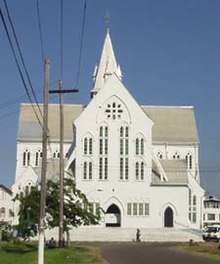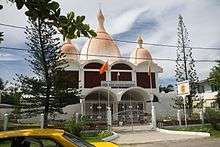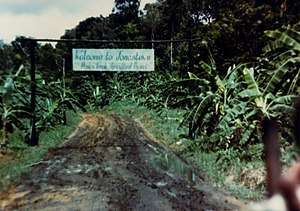Religion in Guyana
Christianity and Hinduism are the dominant religions in Guyana. According to the 2012 census, approximately 63 percent of the population is Christian. The major groupings compose:
- Pentecostal, 22.8% of the national population, increasing from 17% in 2002
- Anglican, 5.2%, decreasing from 7%, and
- Seventh-day Adventist, 5.4%, increasing from 5% in 2002
- Roman Catholicism, 7.1%, decreasing from 8,1%
- other Christian groups, 20.8%, increasing from 17.9%.
According to the 2012 census, approximately 25 percent are Hindu, 7 percent are Muslim (mostly Sunni with Shia and Ahmadiyya minorities), and 1 percent practice other beliefs, including the Rastafari movement, Buddhism, and the Baha'i Faith. More than 3 percent of the population do not profess any religion.[3] Between 1991 and 2012, Hinduism, Islam, Catholicism and Mainline Protestant churches all saw significant decline as the national population grew by 3%. This is in contrast to Pentecostalism, which more than doubled, and less-established Christian groups, which nearly quadrupled in the same period.[1]
The country is ethnically diverse, reflecting East Indian, African, Chinese, and European ancestry, as well as a significant indigenous population. Members of all ethnic groups are well represented in all religious groups, with two exceptions: most Hindus are Indo-Guyanese, and nearly all Rastafarians are Afro-Guyanese. Foreign missionaries from many religious groups are present.[3]
Christianity's status as Guyana's dominant system of values is a consequence of colonial history. To the European planters, colonial administrators, and missionaries, the profession of Christian beliefs and observance of Christian practices were prerequisites to social acceptance. Even though the planters discouraged the teaching of their religion to the slaves, Christianity eventually became as much the religion of the Africans as of the Europeans. Indeed, after abolition, Christian institutions played an even more important role in the lives of the former slaves than in the lives of the masters. By the time the East Indians and other indentured groups arrived in Guyana, a new syncretic Afro-Guyanese culture in which Christianity played an important part had already been established. Only since the mid-20th century, with the growth of the Indo-Guyanese population and the efforts of their ethnic and religious organizations, have Muslim and Hindu values and institutions been recognized as having equal status with those of Guyana's Christians.[4]
Religions
Christianity

Among the Christian denominations active in Guyana in the 1990s, the Anglican Church claimed the largest membership: about 125,000 adherents as of 1986 though this had declined to about 40,000 in 2012.[1] Anglicanism was the state religion of British Guiana until independence.
The Roman Catholic Church had a membership of about 94,000 in 1985 which declined to about 53,000 in 2012.[1] The majority of Roman Catholics lived in Georgetown, and the Portuguese were the most active members, although all the ethnic groups were represented.
The Presbyterian Church was the third largest denomination, with nearly 39,000 members in 1980.
Several other Christian churches had significant memberships in 1980, including the Methodists, Pentecostals, and Seventh-day Adventists, each of which had about 20,000 members. There were smaller numbers of Baptists, Jehovah's Witnesses, Congregationalists, Nazarenes, Moravians, Ethiopian Orthodox, and other mainstream Christians. Other sects in Guyana included the Rastafari movement which looks to Ethiopia for religious inspiration, and the Hallelujah Church, which combines Christian beliefs with Amerindian traditions. There were also at least 60,000 people describing themselves as Christian who had no formal church affiliation.[4]
Many rural villages and areas without churches have small gatherings with a group leader, sometimes unofficially called a "pastor" without affiliation to a specific or official Christian church, though most tend to be Baptist or Evangelical in nature. These groups would have "services", bible teachings and discussions at a neighbor's house or a provided empty location. Through organization, a village or a couple of villages might also provide Sunday School for children with a village member donating the space, many times the "bottom house", the empty space under a Guyanese house used for multiple purposes.
Hinduism

The number of Guyanese practising Hinduism has been decreasing for many decades now, with 213,282 (28.4%) reported in 2002 against 253,065 (35.0%) in 1991.[5]
The majority of the East Indian immigrants were Hindu, and their dominant Status differences were attached and rituals varied . The hindus worshipped the classic pantheon of Vishnu and Shiva. Hinduism remains the predominant religion of the Indo-Guyanese, although it has been considerably modified.[4] Hinduism stresses the festivities accompanying religious rites. Festivals may last several days and are usually held in times of crisis or prosperity. Because the sponsor of a festival provides a tent and feeds a large number of guests, orthodox Hindu rituals require considerable outlays of money. A Hindu family has difficulty fulfilling ritual obligations unless it has accumulated a surplus of cash.[4]
Since the late 1940s, reform movements have caught the attention of many Guyanese Hindus. The most important, the Arya Samaj movement (Aryan Society), was founded in India in 1875; the first Arya Samaj missionary arrived in Guyana in 1910. The movement preaches monotheism and opposition to the use of images in worship as well as many traditional Hindu rituals.[4]
Islam
Guyana's Muslims can be organized into orthodox and reform movements. The Sunnatul Jamaat is the orthodox Sunni Islamic movement. The largest Islamic organization in the country is the Guyana United Sadr Islamic Anjuman. The Ahmadiyya sect of Islam, was founded in India in the late nineteenth century; its first missionary to Guyana arrived in 1908. The movement has had considerable success, even including some Afro-Guyanese among its converts. In contrast to the situation found on the Indian subcontinent, Muslims and Hindus experience little friction in Guyana. These two religious communities have a tacit agreement not to proselytize each other's members. In smaller villages, Hindus and Muslims come together to participate in each other's ceremonies.[4] The Muslims are split into Shias, Sufis, Sunnis and Ahmadiyyas.
Until the 1970s, Hindu and Muslim holidays were not officially recognized. A number of non-Christian religious days are now public holidays. Hindu holidays include Holi, the spring festival, and Divali, the festival of lights. Muslim holidays include Eid al-Fitr, the end of Ramadan, the sacred month of fasting; Eid al-Adha, the feast of sacrifice; and Mawlid, the birthday of Muhammad. The dates for these holidays vary. An East Indian heritage day is celebrated and on May 5, an Amerindian festival is held on Republic Day, in February.[4]
Bahá'í Faith
The Bahá'í Faith is a relatively recent addition to the list of world religions represented in Guyana with the first local body (Local Spiritual Assembly) being established in Georgetown in 1955. National recognition came in 1976 when the National Spiritual Assembly of the Bahá'ís of Guyana was incorporated by Act of Parliament. This body represents all Bahá'ís in Guyana.
The 2002 Census enumerated 500 Bahá'ís.[5]
The Bahá'í community, while relatively small, is well known for its emphasis on unity, non-involvement in politics and its work in issues such as literacy and youth issues.[6][7]
In terms of religious practices and teachings the Guyana Bahá'í community closely follows those of Bahá'í communities in other countries.
Judaism
Jews first came to Guyana in the 1660s, when Jewish settlers arrived in what was then the Dutch colony of Essequibo.[8] Janet Jagan, an American-born Jewish woman, served as prime minister from March 17, 1997, to December 19, 1997, and as president of Guyana from December 19, 1997, to August 11, 1999.[9]
Obeah
A number of folk beliefs continue to be practiced in Guyana. Obeah, a folk religion of African origin, incorporates beliefs and practices of all the immigrant groups. Obeah practitioners may be Afro-Guyanese or Indo-Guyanese, and members of all the ethnic groups consult them for help with problems concerning health, work, domestic life, and romance. Some villagers wear charms or use other folk practices to protect themselves from harm.[4]
Indigenous religions
Traditional Amerindian religious beliefs vary, but shamans play a significant role in all of them. The shaman is believed to communicate with the world of spirits in order to detect sorcery and combat evil. The shaman is also a healer and an adviser, the representative of the village to the spiritual world and sometimes its political leader as well. Missionary activity to the Amerindians has been intense. As a result, the traditional beliefs and practices of all the Amerindian groups have been modified; some have even disappeared.[4]
House of Israel
The House of Israel was established by an American fugitive, David Hill, also known as Rabbi Edward Washington, who arrived in Guyana in 1972. In the 1970s, the group claimed a membership of 8,000. The House of Israel had a daily radio program in which it preached that Africans were the original Hebrews. Opponents of the government claimed that the House of Israel constituted a private army for Guyana's ruling party, the People's National Congress (PNC). During an anti-government demonstration, a House of Israel member murdered a Roman Catholic priest because he was on the staff of a religious opposition newspaper, the Catholic Standard. The House of Israel also engaged in strikebreaking activities and disruptions of public meetings. Critics of the government alleged that House of Israel members acted with impunity during the government of Linden Forbes Burnham. However, under Hugh Desmond Hoyte, Burnham's successor, Rabbi Washington and key associates were arrested on a long-standing manslaughter charge and imprisoned.[4]
Cults

Guyana acquired international notoriety in November 1978 following a mass murder-suicide at Jonestown, the commune of the People's Temple of Christ, led by the Reverend Jim Jones, of Oakland, California. Allegations of atrocities by commune leaders and charges that the commune was holding people against their will led United States Congressman Leo Ryan to go to Jonestown to investigate. Fearing the exposure from Ryan's report, Jones had the congressman murdered. He then coerced and cajoled over 900 members of the commune to commit murder and suicide.[4]
Regional religious demographics[5]
As with most countries, religious composition varies somewhat from region to region. The regions mentioned vary greatly from each other in population. The most populated region, region 4, has the highest number of followers of almost any given major religion. Christianity remains the dominant religion of all races, influencing the cultural and legal sections of the country.
Anglican affiliation is most prominent in region 7 (Cuyuni-Mazaruni) at 17.5% and region 9 (Upper Takutu-Upper Essequibo) at 14.9%. It makes up the smallest percentage of the population in region 1 (Barima-Waini) at only 2.5% of its overall population. On average, people who stated Anglicanism as their religious preference account for 5.2% of Guyana's total population, or just under 39,000 people.
Methodists constitute about 1.4% of the Guyanese population (approximately 10,100 people). Region 4, or Demerara-Mahaica has the largest percentage of Methodists at 2.0%; region 1 (Barima-Waini) has the least, only 0.1%.
Pentecostals make up more of the Guyanese Christian population than any other denomination, and its numbers vary wildly from region to region. Overall, they make up 22.8% of the nation, or more than 170,000 people. Pentecostalism is least popular in region 9 (Upper Takutu-Upper Essequibo (where Anglicans and Roman Catholics both have a statistically strong presence), where it accounts for only 1.6% of region's total. It is most prevalent in region 1, where it is adhered to by 39.9%.
The Roman Catholic Church's numbers also vary greatly. In total, Roman Catholics make up 7% of the population (around 52,900 people). However, regions 1, 8, and 9 are 33.8%, 39.8%, and 50.1% Catholic, respectively.
Seventh-day Adventists account for 5% of the total population, or 40,400 people. It is most popular in Cuyuni-Mazaruni, or region 7, where Seventh-day Adventists make up 17.3% of the region. Its lowest is in region number 9, with only 2.1% of Guyanese listing their religious adherence as Seventh-Day Adventism.
Jehovah Witnesses make up around 1.3% (or a bit over 9,600 people) of Guyana's total population. The religion is most popular in Barima-Waini (region 1) and Upper Demerara-Berbice (region 10); about 2% of people living in these regions list themselves as followers of the faith.
Christians not falling under any of the above denominations make up at least one tenth of the population in every region of Guyana. They are 20.8% (about 155,000) of the population. Christians of other (or no) denomination amass to 31.6% in Potaro-Siparuni (region 8) and 28.15% in Upper Demerara-Berbice (region 10); these two regions have the highest proportions of Christians of other denominations.
Hinduism accounts for the religious preference of 185,000 people (24.8%) in the country. Its highest percentages are in region 3 (Essequibo Islands-West Demerara) and region 6 (East Berbice Corentyne) at 37.7% and 42.1% of the regional population respectively.
Islamic people total 50,600 in Guyana, making up 6.8% of the national population. Essequibo Islands-West Demerara (region number 3) has the highest percentage of Muslims, 11.8%. Barima-Waini (region 1) contains the lowest Islamic percentage at 0.3% of its regional population.
Rastafari is adhered to by 0.5% (around 3,500) of Guyanese people. 1.3% of people living in the 10th region of Guyana (Upper Demerara-Berbice) are Rastas, a higher percent than any other region. The lowest percent of Rastafarians in any region is 0.1% in region number 2 (Pomeroon-Supenaam).
Religion and politics
Through much of Guyana's history, the Anglican and Roman Catholic churches helped maintain the social and political status quo. The Roman Catholic Church and its newspaper, the Catholic Standard, were vocal opponents of the ideology of the People's Progressive Party (PPP) in the 1950s and became closely associated with the conservative United Force. However, in the late 1960s the Roman Catholic Church changed its stance toward social and political issues, and the Catholic Standard became more critical of the government. Subsequently, the government forced a number of foreign Roman Catholic priests to leave the country. By the mid-1970s, the Anglicans and other Protestant denominations had joined in the criticisms of government abuse. The Anglican and Roman Catholic churches also worked together, unsuccessfully, to oppose the government's assumption of control of church schools in 1976.[4]
The Guyana Council of Churches was the umbrella organization for sixteen major Christian denominations. Historically, it had been dominated by the Anglican and Roman Catholic churches. The Guyana Council of Churches became an increasingly vocal critic of the government in the 1970s and 1980s, focusing international attention on its shortcomings. The conflict between the government and the Guyana Council of Churches came to a head in 1985, when members of the PNC-influenced House of Israel physically prevented the council from holding its annual meeting. Later that year, police searched the homes of the major Christian church leaders. The PNC maintained the support of a number of smaller Christian denominations, however.[4]
In contrast to the most prominent Christian clergy, who maintained connections with international denominations, Hindu and Muslim leaders depended on strictly local support. For them, resistance to political pressure was more difficult. In the 1970s, the PNC succeeded in splitting many of the important Hindu and Muslim organizations into pro-PNC and pro-PPP factions.[4]
Freedom of religion
The Constitution of Guyana provides for freedom of religion, and the Government generally respects this right in practice. The U.S. government could locate no reports of societal abuses or discrimination based on religious belief or practice during 2007, and prominent societal leaders took positive steps to promote religious freedom.[3]
In September 2009, forty mainly U.S. citizen missionaries from The Church of Jesus Christ of Latter-day Saints were detained briefly. Subsequently the 100+ missionaries were ordered to leave the country within a month. In addition to its missionary work, The Church of Jesus Christ of Latter-day Saints owns approximately $2 million in property in Guyana, and cultivate farms in the country. Missionaries have worked in the country for more than 20 years.[10][11]
Notes
- Mostly made up of other Protestants, but also Eastern Orthodox, Mormons, and other Christians.
References
- Guyana 2012 census compendium 2. Retrieved 28 August 2019.
- "Guyana 2016 International Religious Freedom Report" (PDF). United States Department of State. Archived from the original (PDF) on 2017-08-15.
- "Guyana 2007 International Religious Freedom Report". 2001-2009.state.gov. 14 September 2007.
- Conway, Frederick J. "Religion" (and subsections). A Country Study: Guyana (Tim Merrill, editor). Library of Congress Federal Research Division (January 1992). This article incorporates text from this source, which is in the public domain.
- "Population and Housing Census 2002 Census" (PDF). Statistics Bureau. 2002. Retrieved 15 August 2009.
- "Independent Evaluation of Youth Can Move the World". Varqa Foundation. July 2000. Retrieved 15 August 2009.
- "Religion can help fight AIDS, says study" (PDF). One Country. Dec 2007. Retrieved 15 August 2009.
- Mordechai Arbell (2003). The Portuguese Jews of Jamaica. Canoe Press. p. 3. ISBN 978-9768125699.
- J.J. Goldberg (April 1, 2009). "Guyana Leader Was Always Her Own (Jewish) Woman". The Forward. Retrieved 2013-08-06.
- Wilkinson, Bert (3 September 2009). "Authorities `uncomfortable' with LDS missionaries in Guyana". www.ksl.com.
- Wilkerson, Bert (2 September 2009). "US Latter-day Saint missionaries to be deported from Guyana". www.ksl.com.